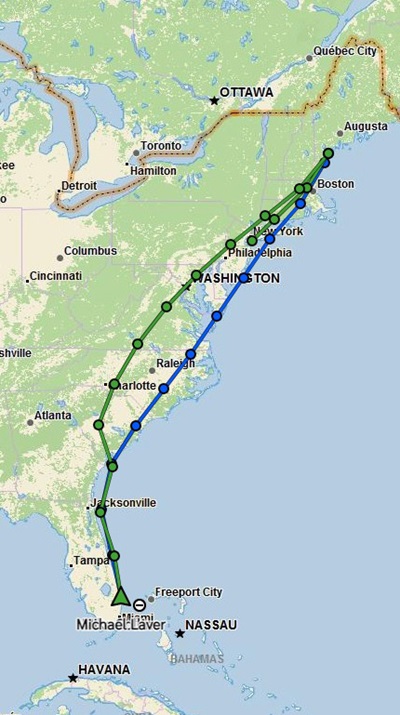Winglets allow nonstop Maine-to-Florida flight
Fly-off compared Tamarack-modified, stock CitationJets
Weather played a big part in a dramatic fly-off between two Cessna CitationJets, one with and one without Tamarack’s active winglets. And the winner was…
The weather proved a wild card in the January 26 real-world comparison between a Cessna CitationJet equipped with Tamarack’s ATLAS Active Winglet system (N44VS) and an unmodified, “flat-wing” CitationJet (N741CC). Both aircraft battled stronger-than-forecast headwinds, and the unmodified jet had to fly west of an energetic weather system in the eastern Carolinas to make a fuel stop. The National Aeronautic Association documented the race for a potential speed record between the city pair for this aircraft class.
Unmodified N741CC traveled a total of 1,496 miles; spent five hours, 37 minutes in flight; and burned 3,650 pounds of fuel. N44VS could take a more direct route, flying 1,386 miles, spending four hours and 36 minutes in the air, and used a total of 2,610 pounds of fuel. That 1,040-pound difference equates to 155 gallons of fuel.

AOPA documented the fly-off, with multimedia journalists aboard both of the participating aircraft. A more detailed report will be published on AOPA Online soon.
“Active winglet mods on Citations can result in up to a 33-percent fuel savings, depending on weather conditions and other variables, so the active winglet competitor may make the [approximately] 1,292-mile trip without a stop," said Tamarack CEO Nick Guida, in a news release
N44VS was flown by owner and 30-year pilot Wick Zimmerman, CEO and co-founder of Outside the Lines. N741CC, the unmodified flat-wing aircraft, was flown by aviation veteran Mike Laver, owner of Carolina Turbine Support. Laver and AOPA Pilot Technical Editor Mike Collins flew Laver’s personal Mitsubishi MU-2 around the world in 2013.
“The fly-off is very exciting. I’m going to do my best to win the race,” Laver said prior to the flight. “This kind of race has never been done before, and it will put to rest once and for all any question about the value of these active winglet installations. I’ll pay attention to how high and how fast the active winglet jet performs.”
“I am very pleased with how the Active Winglets performed,” said Wick Zimmerman, who flew the Tamarack active-winglet-equipped aircraft. “Active Winglets provide dramatic fuel savings, increased safety benefits, and much more. I am glad that the aviation industry is able to see this game changing technology in action.”
Zimmerman made several cross-country flights that required multiple expensive and time-consuming fuel stops before he invested in active winglets for his CitiationJet. “Active winglets also make a dramatic difference getting into and out of places that are high and hot,” he added. “For example, when we’re operating out of Salt Lake City, the takeoff and climb is a game-changer. With Tamarack winglets, we went straight up to 40,000 in just under 26 minutes. We were still climbing at 500-plus feet per minute when we leveled off.”
Tamarack’s ATLAS Active Winglets comprise a wing extension, a winglet, and an autonomous load alleviation system. The active winglet technology features instantaneous adjustment to turbulence, affording smoother and safer flights, quicker climbs, fewer stops, up to 33 percent reduced fuel use, and more stable approaches, the company said.
Laver decided to participate in the race before his business in Aiken, South Carolina, was named Tamarack’s new East Coast Transformation Center.




